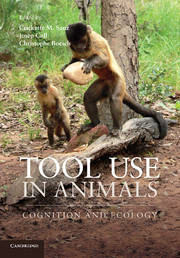Book contents
- Frontmatter
- Contents
- List of contributors
- Part I Cognition of tool use
- Part II Comparative cognition
- Part III Ecology and culture
- Part IV Archaeological perspectives
- 11 From pounding to knapping: How chimpanzees can help us to model hominin lithics
- 12 Early hominin social learning strategies underlying the use and production of bone and stone tools
- 13 Perspectives on stone tools and cognition in the early Paleolithic record
- Index
- References
12 - Early hominin social learning strategies underlying the use and production of bone and stone tools
from Part IV - Archaeological perspectives
Published online by Cambridge University Press: 05 March 2013
- Frontmatter
- Contents
- List of contributors
- Part I Cognition of tool use
- Part II Comparative cognition
- Part III Ecology and culture
- Part IV Archaeological perspectives
- 11 From pounding to knapping: How chimpanzees can help us to model hominin lithics
- 12 Early hominin social learning strategies underlying the use and production of bone and stone tools
- 13 Perspectives on stone tools and cognition in the early Paleolithic record
- Index
- References
Summary
Introduction
Current trends in research toward the integration of primatological and archaeological models have provided significant insight into the emergence of tool use from a multidisciplinary perspective (e.g., Wynn & McGrew 1989; van Schaik et al., 1999; Backwell & d’Errico, 2001, 2008, 2009; d’Errico et al., 2001; Mercader et al., 2002, 2007; van Schaik & Pradhan, 2003; Marzke, 2006; Lockwood et al., 2007; Sanz & Morgan, 2007; Carvalho et al., 2008, 2009; Gowlett, 2009; Haslam et al., 2009; Hernandez-Aguilar, 2009; Uomini, 2009; Visalberghi et al., 2009; Whiten et al., 2009a; Chapter 11). Recently, this has culminated in the new “primate archaeology” subdiscipline (Haslam et al., 2009), which has effectively modeled the advantages of incorporating comparative primatological research within the study of early hominin technologies. While this approach advances a unique perspective concerning the evolution of tool use and production, the predominantly ethological focus of primate archaeology has not fully benefited from exploring neuro-cognitive mechanisms in non-human primates and modern humans that might pertain to tool use in the deep past. Cognition remains a critical element in archaeological and paleoanthropological theories regarding the nature of early hominin technologies (e.g., Toth, 1985; Semaw, 2000; Delagnes & Roche, 2005; Stout et al., 2008; Whiten et al., 2009a). Thus, examining the cognitive capacities underlying tool use within the Order Primates is a critical pursuit toward understanding the social and cultural contexts of tool-mediated behavior, and the evolution of technology (van Schaik et al., 1999; van Schaik & Pradhan, 2003; see also Chapters 2, 3 and 10). This chapter presents and explores various primatological perspectives concerning tool use, and cognitive approaches regarding the emergence of technology within the hominin lineage. The infusion of cognitive perspectives within the primate archaeology framework is imperative for defining the biological, sociocultural and ecological contexts of tool use and production, thus enhancing its interpretive potential.
Information
- Type
- Chapter
- Information
- Tool Use in AnimalsCognition and Ecology, pp. 242 - 285Publisher: Cambridge University PressPrint publication year: 2013
References
Accessibility standard: Unknown
Why this information is here
This section outlines the accessibility features of this content - including support for screen readers, full keyboard navigation and high-contrast display options. This may not be relevant for you.Accessibility Information
- 8
- Cited by
